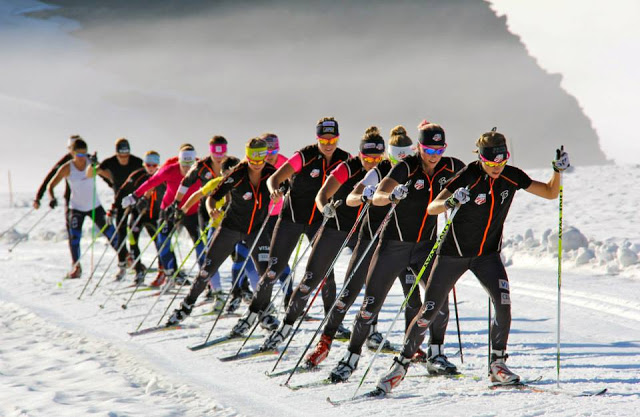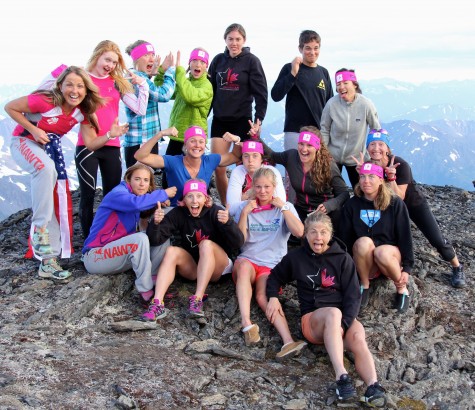
In advance of his club’s facility playing host to the third annual North American Women’s Training Alliance (NAWTA) camp last month, Alaska Pacific University (APU) Nordic Director Erik Flora broke down film of last year’s World Cup races in Sochi, Russia.
His focus wasn’t on the skiing, even though several of the athletes planning to attend the camp on Eagle Glacier were featured in the video. He was studying every undulation of the race courses, with a goal to replicate the Olympic venue.
The altitude and topography of the widely separated parts of the world is similar enough to make the project worthwhile. Referencing course profiles and maps, Flora and APU wax techs Mike Matteson and Don Haering logged 16 to 20 hours daily constructing and maintaining the trail system.

The women’s U.S. Ski Team (USST) joined the APU elite women, a few National Training Group skiers and international guests Astrid Jacobsen, of Norway, and Switzerland’s Bettina Gruber for a week of dryland training, followed by a week of living and skiing on the remote glacier.
According to U.S. women’s coach Matt Whitcomb, the skiers woke to blazing fast skating conditions every morning, which softened in the sun to create wildly variable classic tracks in the afternoon.
“It’s rare and productive when you can train on that range of conditions in a single session,” Whitcomb wrote in an email. “Striding in tricky classic conditions is something our women’s team can improve on, so these sessions are really important.”
As much as they learned from the snow, which transformed in similar patterns to what they remembered of the Sochi race-day conditions, the women might have learned more from one another.
“With eight World Cup racers at a camp, it’s rare that the same person leads every day,” Whitcomb wrote. “Everyone had a session where they could put their best strength to work, and of course a session when they got absolutely trounced.”
Jacobsen is regarded as one of the best technical classic skiers in the world. She was the 2007 World Champion in the classic sprint and placed third in the 3-kilometer classic prologue in the third stage of last year’s Tour de Ski.
U.S. star Kikkan Randall earned the same respect for her skating ability, which she has ridden to the last two World Cup sprint titles.
At the end of the competition season, Randall extended an invitation to Jacobsen, not really expecting her to accept as athletes don’t typically do anything too out-of-the-norm in an Olympic year.
Flying in star athletes from traditionally dominant skiing nations brings the untouchable down to eye level, Whitcomb said. U.S. skiers are seeing that they have all the same tools, and maybe even some advantages. In a phone interviews, Randall said that Jacobsen seemed to admire the positive team dynamic of the U.S. women.
“Before, we felt that we had to know the course and know the snow and everything had to be perfect [to be successful],” Randall said. “I think what our good results have shown over the last few years is that if we’re in shape, I think we can encounter everything.”
The primary difference Randall sees in the training philosophies of the Norwegian and American national teams is the value U.S. coaches place on time in the weight room. Randall said her team puts more of an emphasis on Olympic-style lifts, which develop explosiveness and functional strength, than some other nations.

Training logs aside, Randall said one of the most valuable things she gained from spending a couple of weeks with Jacobsen and Gruber was two more friends to keep in touch with during five long winter months of travel.
The NAWTA name originated in 2011 when Canadian World Cup skiers Chandra Crawford and Perianne Jones joined the annual USST glacier camp. Last year, Finnish sprinter Aino-Kaisa Saarinen was the team’s international guest.
This year’s camp schedule listed two skiing sessions daily, with skating first every day except the one they started with classic intervals. Everyone shared chore duties, including meal prep, dishes and cleanup. They also had to prep their own skis for each workout.
On the fourth day on the glacier, the coaches spiced up the workout with a sprint relay, covered by several media outlets that flew in for the day to see Flora’s creation and get some perspective on how this camp will help the women prepare for Sochi.
Even with a twin of the Olympic venue in her back yard, an experienced Randall knows familiarity with the courses alone will not decide the podium in February.
“I guess what I’ve learned over my previous three Olympic experiences is if you prepare well and you show up at the Olympics rested, healthy and in good shape, then you’re really ready to conquer anything,” Randall said.
Steven McCarthy
Steven McCarthy discovered a passion for sportswriting in the classrooms of the University of Maine school of journalism. He earned his Bachelor's degree in 2010, while complementing his studies covering two years of UMaine sports and summer college baseball on Cape Cod. He resides in southern Maine and works in a private school for kids with autism. In his spare time he's training for his next marathon (running or skiing) or coaching at a local high school.




One comment
Pingback: Fun Youth Ministry Lessons Blog